What kind of rack fits your car, and how much it costs, depends on the type of car you have, and how many bikes you want to carry. You have to check with each rack manufacturer to determine which of their racks best fits your car. However, here's some general information to help you get started.
Bike carriers mount in one of three places on a vehicle: the trunk (or hatch), the roof, or trailer hitch. They carry from two to five bicycles depending on the type of rack and depending on what type racks fits your car.
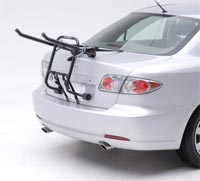 Trunk-mount carriers are the most common type of bike rack. The better trunk-mount racks are easier to install and fit a larger variety of cars. Access to the trunk is difficult with this type carrier, but it is the least expensive type of rack and fits the greatest number of cars.
Trunk-mount carriers are the most common type of bike rack. The better trunk-mount racks are easier to install and fit a larger variety of cars. Access to the trunk is difficult with this type carrier, but it is the least expensive type of rack and fits the greatest number of cars.
You have to check three things to determine whether or not your car will accept a trunk rack.
First, does your car have a spoiler? Although many racks are designed to work around them, spoilers often interfere with the installation of a trunk rack. Sometimes the rack feet won't fit around them. Other times they obstruct the mounting straps.
Second, will the trunk/hatch carry the load? Is the hatch, where the mounting hooks install, framed in metal, rather than glass or plastic? Will the weather stripping allow the mounting hooks to be inserted? Forcing them in could damage the weather stripping and cause a water leak.
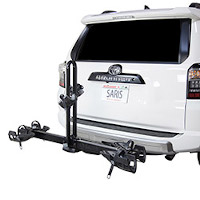
Third, will the rear panel, or bumper, where the bottom feet of the rack rest, support the load? The large rear panels on vans, for example, are very thin and will dimple in if too much weight is applied there. It’s best to have the rack rest on the bumper in this case. However, bumpers too must be checked for strength as more and more plastic is used in them these days and they may not be strong enough to carry the load. (If the bumper won't support the weight, the lower feet of a rack can often rest in the license plate area or on the vertical panel at the rear of the trunk.)
In any case, you have to check for spoilers, examine the trunk/hatch construction, and check the strength of the vehicle where the lower feet of the rack will rest before installing a trunk rack on your car.
If a trunk rack doesn’t fit your car, a hitch rack is a good solution, assuming, of course, that you have a hitch on your car. (Hitches cost around $180 if you need one installed. We'll be happy to refer you to someone for that work.)
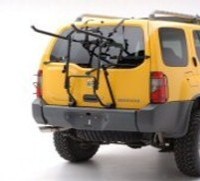 | 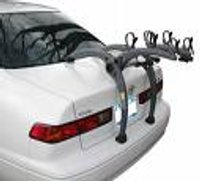 |
The two main benefits of hitch racks are that it's a little easier to put your bikes on them, and that they are very easy to install on your car, usually with just one bolt.
Hitches racks come in two sizes: an inch and a quarter and two inch, to fit their respective size hitches. The two inch hitches are more common and carry a bigger load, anywhere from two to five bikes. The inch and a quarter versions carry less weight, and thus, fewer bikes, usually three bikes max. Most hitch racks will pivot or retract in some fashion to allow access to your cargo space.
Caution: You do have to remember that your bikes are back there when you’re backing up though. They stick out a lot.
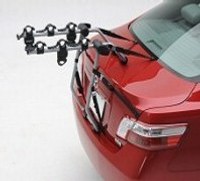 If neither a trunk or hitch rack suits your needs, a roof top carrier offers a third alternative for carrying your bike. Although the most expensive type rack, roof racks are the most versatile. They can be adapted to carry skis, kayaks, surfboards, and even lumber. They also keep your cargo space accessible. These are typically a-la-carte type systems where you select the particular set up you want, depending on what you want to carry. For bicycles, you’ll have a choice of carrying your bike with or without the front wheel attached. Carrying your bike with the wheel attached is more convenient. However, carrying it without the wheel attached, where the bike is fastened to the rack by the front fork, is slightly more secure and gives more overhead clearance when you drive under things. The front wheel can be put inside the car, or you can get a wheel carrier for putting it on the rack.
If neither a trunk or hitch rack suits your needs, a roof top carrier offers a third alternative for carrying your bike. Although the most expensive type rack, roof racks are the most versatile. They can be adapted to carry skis, kayaks, surfboards, and even lumber. They also keep your cargo space accessible. These are typically a-la-carte type systems where you select the particular set up you want, depending on what you want to carry. For bicycles, you’ll have a choice of carrying your bike with or without the front wheel attached. Carrying your bike with the wheel attached is more convenient. However, carrying it without the wheel attached, where the bike is fastened to the rack by the front fork, is slightly more secure and gives more overhead clearance when you drive under things. The front wheel can be put inside the car, or you can get a wheel carrier for putting it on the rack.
The two issues with roof racks are that, one, they’re difficult to reach, since they're so high up, and two, you have to remember that your bikes are up there when you enter garages and drive under over-hangs. Lots of folks have damaged their bikes forgetting that they were up there.
Other specialized types of racks are made for vehicles that don't accept trunk, hitch, or rooftop carriers. Cars with spare tires on the back, pick up trucks, and some vans and SUVs required specific racks to fit them.
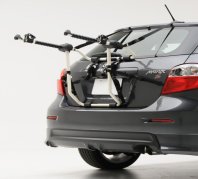 | 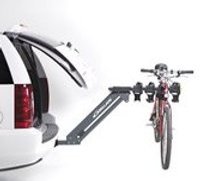 |
In addition to your rack, you may want to pick up a couple of other accessories. You might need a lock and cable to guard against theft when you travel with your bikes. A couple of bunji cords are always handy for tie-downs. If you have a ladies bike, or some other type of bike without a top bar, you may want to get a Boomer Bar, an accessory that creates a top bar by which to hang your bike on the rack.
And finally, a few notes on using trunk racks.
- Be sure there’s no sand or grit on the car or rack feet that might scratch the paint when you put the rack on your car.
- Take care not to accidentally fling the straps. The hooks on the end of them will nick the paint.
- Retighten the lower straps after loading your bikes. Some slack will develop in them once the bikes are on the rack.
- Turn the pedal on the first bike you load, so that it rests on the license plate rather than your paint job.
- Be sure you have enough ground clearance to allow for going up and down steep driveways without hitting your wheels on the ground.
- Be sure that your bike tire is not too close to the exhaust pipe. It will melt your tire.
- And finally, before you drive off, double check that the rack is securely fastened to the car, and that the bikes are securely fastened to the rack. There’s nothing that ruins a perfectly good bike like dragging it down the expressway at 70 miles an hour.
Happy Trails!
Mike